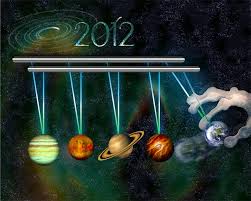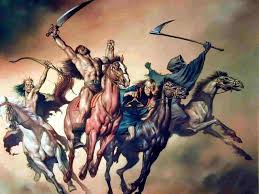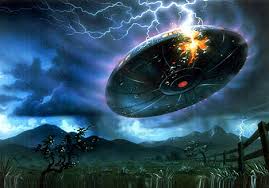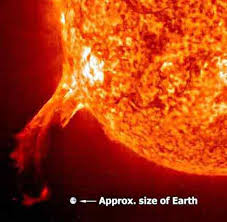I like Ding Ho's for their excellent orange chicken, but also because they provide a copy of our local rag The Fresno Bee. In the Nation & World section, I noticed a headline that I skimmed while waiting for my food. "Russia keeps eye on asteroid," the large font header read with the smaller print subtext following which noted "Space agency floats idea of mission to knock it off course." Ummm, what am I missing here? Are we about to be smacked by a malevolent siderite spitwad emanating from the Big Bang that holds a grudge against Terraneans? I decided I better look into this.
Our government doesn't always inform us of everything an inquiring mind would like to know. Media control. Something about keeping us from panicking? Heck, a lot of people don't even read at a fifth grade level, so that would preclude them from learning anything from newsprint. But I digress. At first glance, the title brought to mind the 1998 Michael Bay extravaganza Armageddon, in which an asteroid the size of Texas is approaching Earth with the intent of pulverizing homo sapiens in the same fashion that Tyrannosaurus Rex was obliterated.
In that movie, it's up to Bruce Willis, playing Harry Stamper -the best deep core driller in the world - to train astronauts who will go to the asteroid, drill 800 feet into the center and detonate a nuclear device. But the velocity with which the asteroid is approaching to play planetary "whack-a-mole" leaves only eighteen days before the lethal collision. That just isn't enough time! So Harry decides to train his team to be astronauts, instead of the other way around. Will his ultimate sacrifice to detonate the nuke himself save the planet from disaster? In Hollywood, viewers like to see happy endings.
So worldwide destruction is averted in the end. This is not quite the same as the fate shared by Morgan Freeman and Tea Leoni in Deep Impact. In that 1998 film Leoni stars as Jenny Lerner, a reporter for MSNBC in Washington, DC. She inadvertently uncovers government awareness of an extinction level event that is imminent. Her investigatory persistence leads President Beck, played by Morgan Freeman, to conclude that "it's time to tell the public." A seven mile wide comet is about to strike the Earth. A spacecraft named Messiah is readied to address the crisis.
After an abortive effort to destroy the comet, one large fragment does make deep impact (remember 3rd grade summer school, and Billy "Fatso" Whittaker, doing the Cannonball?) in the Atlantic Ocean near Virginia Beach and Cape Hatteras, creating a mega-tsunami about 1,000 to 3,500 ft high. Jenny and her father perish, along with millions of others on America's east coast, Europe, and Africa. But a larger portion of the comet - dubbed "Wolf," after the astronomer who confirmed its existence - is still on a collision course with Western Canada. When it strikes it will create a sun-obscuring dust cloud that will linger for years, resulting in starvation for any survivors.
Hollywood arrives again, just in time with a happy ending, albeit one not completely unmarked by tragic loss of life. The comet is blasted to smithereens by the couragious actions of the fearless crew (so that the minnows would not be lost) of the Messiah , a spaceship constructed by the bilateral efforts of the governments of the United States and Russia. The fragment residue falls harmlessly to Earth, where it burns up on entry through the atmosphere. Humanity is saved. Both of these movies capitalized on a hysteria that would prove as real as that portrayed, if such an event were about to occur.
Is this likely to happen? Is it even remotely possible? What do scientists, not scriptwriters, have to say on the subject? From Wikipedia we learn an impact event is the collision of a large meteorite, asteroid, or comet with the Earth. Asteroids with a 1 km diameter strike the Earth every 500,000 years on average. Larger collisions - with five kilometer objects - happen approximately once every ten million years. The last known impact of an object of 10 km or more in diameter was at the Cretaceous-Tertiary extinction event 65 million years ago. In layman's terms, that's when the dinosaurs got creamed.
We've all seen the displays of meteor showers. So we know that gravel-sized pebbles of nickel/iron ore do roam the galaxy, if only to provide spectacular visual spectacle as they incinerate in incandescent display as they enter planetary atmospheres. A schedule of these annual light shows is available at: www.theskyscrapers.org/meteors/. This link informs us that on August 12 and 13, 2010 we will be able to view the Perseids. The parent comet, 109P/Swift-Tuttle, produces about 60 meteors per hour, and its performance is fairly consistent from year to year.
Skyscraper's Inc., is maintained by The Amateur Astronomical Society of Rhode Island. They are an educational, non-profit organization with the purpose of educating the general public and membership on matters pertaining to astronomy. This site also informs us that we will be able to view the Geminids on December 13, and 14, 2010. Issuing from parent comet 3200 Phaethon, the Geminids are characterized by their multi-colored display--65% being white, 26% yellow, and the remaining 9% blue, red and green, and are considered the most reliable meteor shower of the year.
So we witness evidence all about us of astronomical phenomena that could impact the Earth. The smaller stuff? Aw, who cares? But what about collisions with objects that could really endanger our species? Back to Wikipedia. "Asteroids with diameters of 5-10 meters enter the Earth's atmosphere approximately once per year, with as much energy as Little Boy, the atomic bomb dropped on Hiroshima, approximately 15 kilotonnes of TNT. These ordinarily explode in the upper atmosphere and most or all of the solids are vaporized." But would you like to be at Ground Zero when one made it through?
"Objects of diameters of over 50 meters strike the Earth approximately once every thousand years, producing explosions comparable to the one observed at Tunguska on June 30, 1908. Although the cause of the explosion is the subject of debate, it is commonly believed to have been caused by the air burst of a large meteoroid or cometary fragment at an altitude of 5–10 kilometres above the Earth's surface. Estimates of the energy of the blast range from 5 to as high as 30 megatons of TNT, about 1,000 times as powerful as the atomic bomb dropped on Hiroshima, Japan." And this explosion didn't even occur directly on the ground!
 Have you seen the pictures of the destruction that was wreaked by this blast? "The explosion knocked over an estimated 80 million trees over 2,150 square kilometres (830 sq mi). It is estimated that the shockwave from the blast would have measured 5.0 on the Richter scale. An explosion of this magnitude would be capable of destroying a large metropolitan area. This possibility has helped to spark discussion of asteroid deflection strategies.
Have you seen the pictures of the destruction that was wreaked by this blast? "The explosion knocked over an estimated 80 million trees over 2,150 square kilometres (830 sq mi). It is estimated that the shockwave from the blast would have measured 5.0 on the Richter scale. An explosion of this magnitude would be capable of destroying a large metropolitan area. This possibility has helped to spark discussion of asteroid deflection strategies.The Tunguska event is the largest impact event over land in Earth's recent history."
 We know that the Earth has been struck before, with immense destructive force, because of the evidence one can still see at Meteor Crater. About 4,000 feet in diameter, it is some 570 feet deep. It is surrounded by a rim that rises 150 feet above the surrounding plains. Located about 43 miles east of Flagstaff, it is near Winslow, in the northern Arizona desert of the United States. Scientists generally refer to it as Barringer Crater, in honor of Daniel Barringer, who was first to suggest that it was produced by meteorite impact. In 1960, later research by Eugene Shoemaker confirmed that hypothesis.
We know that the Earth has been struck before, with immense destructive force, because of the evidence one can still see at Meteor Crater. About 4,000 feet in diameter, it is some 570 feet deep. It is surrounded by a rim that rises 150 feet above the surrounding plains. Located about 43 miles east of Flagstaff, it is near Winslow, in the northern Arizona desert of the United States. Scientists generally refer to it as Barringer Crater, in honor of Daniel Barringer, who was first to suggest that it was produced by meteorite impact. In 1960, later research by Eugene Shoemaker confirmed that hypothesis.What focused the Russian's attention in the first place, resulting in this news item, was the approach of near-Earth asteroid 2004 MN4, now referred to as Apophis. Relying again on Wikipedia we learn that Apophis is the Greek name of the Ancient Egyptian enemy of Ra: Apep, the Uncreator, a serpent that dwells in the eternal darkness of the Duat (earth's middle) and tries to swallow Ra during His nightly passage. Apep is held at bay by Set, the Ancient Egyptian god of Chaos. Apophis was initially projected to have a 2.7% chance of striking Earth in 2029.
The Torino Scale is a method for categorizing the impact hazard associated with near-Earth objects such as asteroids and comets. It is intended as a tool for astronomers and the public to assess the seriousness of collision predictions, by combining probability statistics and known kinetic damage potentials into a single threat value. It has since been determined that the original calculations were faulty, and the asteroid is given an impact probability of only 1 in 250,000 chance in 2036. This recalculation of the trajectory of the asteroid caused it to be downgraded from a 4 to a zero on the Torino Scale.
So do the Russians know something we don't? Or is it that their mathematicians just don't trust ours? Is there a massive program underway in the Southern Siberian steppes even now, to hollow out cavernous enclaves suitable to sustain the Muskovy elite in the event of a meteor impact? Is the lack of concern by our media a gigantic government coverup to prevent panic? Are we being told the truth? Whatever the case may be, truth may be stranger than fiction. If the Russians figure they can defuse any future threat by launching a spacecraft to knock Apophis off course, then they've been watching too many American movies.












































No comments:
Post a Comment